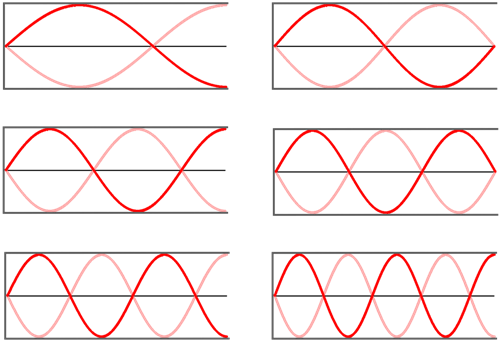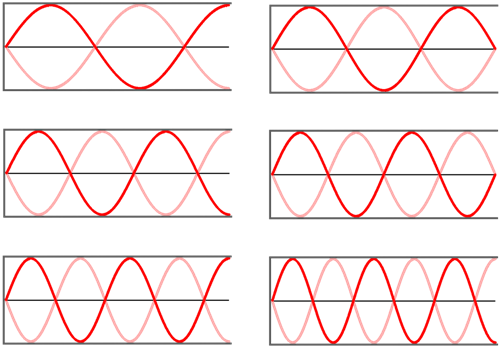Name That Harmonic: Closed-End Air Columns - Questions
The Name That Harmonic: Closed-End Air Columns Concept Builder is comprised of 30 questions. The questions are divided into 14 different question groups. Questions in the same group are rather similar to one another. The Concept Builder is coded to select at random a question from each group until a student is successful with that group of questions.
There are three different activities that can be engaged in through the Concept Builder. Those three activities are differentiated as follows:
- ID the Pattern: Question Groups 1-6 ... Students must identify the standing wave patterns for the first six harmonics of a resonating, closed-end air column.
- Frequency: Question Groups 7-10 ... Students are given the fundamental frequency and the frequency of an unknown harmonic. They must identify the standing wave pattern for that harmonic.
- Wavelength: Question Groups 11-14 ... Students are given the length of a closed-end air column and the wavelength of an unknown harmonic. They must identify the standing wave pattern for that harmonic.
The questions from each group are shown below. Teachers are encouraged to view the questions in order to judge which activities are most appropriate for their classes.
The Physics Classroom grants teachers and other users the right to print these questions for private use. Users are also granted the right to copy the text and modify it for their own use. However, this document should not be uploaded to other servers for distribution to and/or display by others. The Physics Classroom website should remain the only website or server from which the document is distributed or displayed. We also provide a PDF that teachers can use under the same conditions. We have included a link to the PDF near the bottom of this page.
Name That Harmonic: Closed-End Air Columns
Activity 1: ID the Pattern
Question Group 1
Question 1
Identify the standing wave pattern for a closed-end air column that is vibrating with a first harmonic wave pattern.
Question Group 2
Question 2
Identify the standing wave pattern for a closed-end air column that is vibrating with a third harmonic wave pattern.
Question Group 3
Question 3
Identify the standing wave pattern for a closed-end air column that is vibrating with a fifth harmonic wave pattern.
Question Group 4
Question 4
Identify the standing wave pattern for a closed-end air column that is vibrating with a seventh harmonic wave pattern.
Question Group 5
Question 5
Identify the standing wave pattern for a closed-end air column that is vibrating with a ninth harmonic wave pattern.
Question Group 6
Question 6
Identify the standing wave pattern for a closed-end air column that is vibrating with an eleventh harmonic wave pattern.
Question Group 7
Question 7
The fundamental or first harmonic frequency of a closed-end air column is 80 Hz. The same air column is capable of vibrating with several other standing wave patterns. Identify the standing wave pattern for the harmonic that has a frequency of 240 Hz.
Question 8
The fundamental or first harmonic frequency of a closed-end air column is 60 Hz. The same air column is capable of vibrating with several other standing wave patterns. Identify the standing wave pattern for the harmonic that has a frequency of 180 Hz.
Question 9
The fundamental or first harmonic frequency of a closed-end air column is 120 Hz. The same air column is capable of vibrating with several other standing wave patterns. Identify the standing wave pattern for the harmonic that has a frequency of 360 Hz.
Question Group 8
Question 10
The fundamental or first harmonic frequency of a closed-end air column is 80 Hz. The same air column is capable of vibrating with several other standing wave patterns. Identify the standing wave pattern for the harmonic that has a frequency of 400 Hz.
Question 11
The fundamental or first harmonic frequency of a closed-end air column is 100 Hz. The same air column is capable of vibrating with several other standing wave patterns. Identify the standing wave pattern for the harmonic that has a frequency of 500 Hz.
Question 12
The fundamental or first harmonic frequency of a closed-end air column is 120 Hz. The same air column is capable of vibrating with several other standing wave patterns. Identify the standing wave pattern for the harmonic that has a frequency of 600 Hz.
Question Group 9
Question 13
The fundamental or first harmonic frequency of a closed-end air column is 60 Hz. The same air column is capable of vibrating with several other standing wave patterns. Identify the standing wave pattern for the harmonic that has a frequency of 420 Hz.
Question 14
The fundamental or first harmonic frequency of a closed-end air column is 80 Hz. The same air column is capable of vibrating with several other standing wave patterns. Identify the standing wave pattern for the harmonic that has a frequency of 560 Hz.
Question 15
The fundamental or first harmonic frequency of a closed-end air column is 100 Hz. The same air column is capable of vibrating with several other standing wave patterns. Identify the standing wave pattern for the harmonic that has a frequency of 700 Hz.
Question Group 10
Question 16
The fundamental or first harmonic frequency of a closed-end air column is 60 Hz. The same air column is capable of vibrating with several other standing wave patterns. Identify the standing wave pattern for the harmonic that has a frequency of 540 Hz.
Question 17
The fundamental or first harmonic frequency of a closed-end air column is 80 Hz. The same air column is capable of vibrating with several other standing wave patterns. Identify the standing wave pattern for the harmonic that has a frequency of 720 Hz.
Question 18
The fundamental or first harmonic frequency of a closed-end air column is 100 Hz. The same air column is capable of vibrating with several other standing wave patterns. Identify the standing wave pattern for the harmonic that has a frequency of 900 Hz.
Activity 3
Question Group 11
Question 19
A closed-end air column has a length of 30 cm. Identify the standing wave pattern for the harmonic that has a wavelength of 120 cm.
Question 20
A closed-end air column has a length of 25 cm. Identify the standing wave pattern for the harmonic that has a wavelength of 100 cm.
Question 21
A closed-end air column has a length of 20 cm. Identify the standing wave pattern for the harmonic that has a wavelength of 80 cm.
Question Group 12
Question 22
A closed-end air column has a length of 30 cm. Identify the standing wave pattern for the harmonic that has a wavelength of 40 cm.
Question 23
A closed-end air column has a length of 24 cm. Identify the standing wave pattern for the harmonic that has a wavelength of 32 cm.
Question 24
A closed-end air column has a length of 36 cm. Identify the standing wave pattern for the harmonic that has a wavelength of 48 cm.
Question Group 13
Question 25
A closed-end air column has a length of 25 cm. Identify the standing wave pattern for the harmonic that has a wavelength of 20 cm.

Question 26
A closed-end air column has a length of 40 cm. Identify the standing wave pattern for the harmonic that has a wavelength of 32 cm.

Question 27
A closed-end air column has a length of 50 cm. Identify the standing wave pattern for the harmonic that has a wavelength of 40 cm.

Question Group 14
Question 28
A closed-end air column has a length of 35 cm. Identify the standing wave pattern for the harmonic that has a wavelength of 20 cm.
Question 29
A closed-end air column has a length of 42 cm. Identify the standing wave pattern for the harmonic that has a wavelength of 24 cm.

Question 30
A closed-end air column has a length of 70 cm. Identify the standing wave pattern for the harmonic that has a wavelength of 40 cm.
